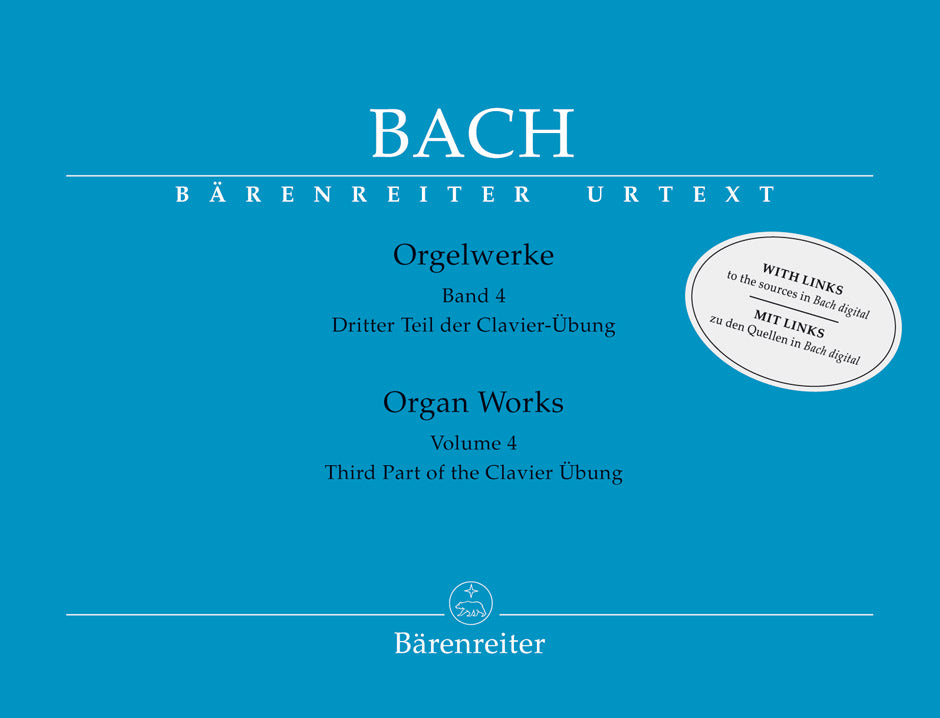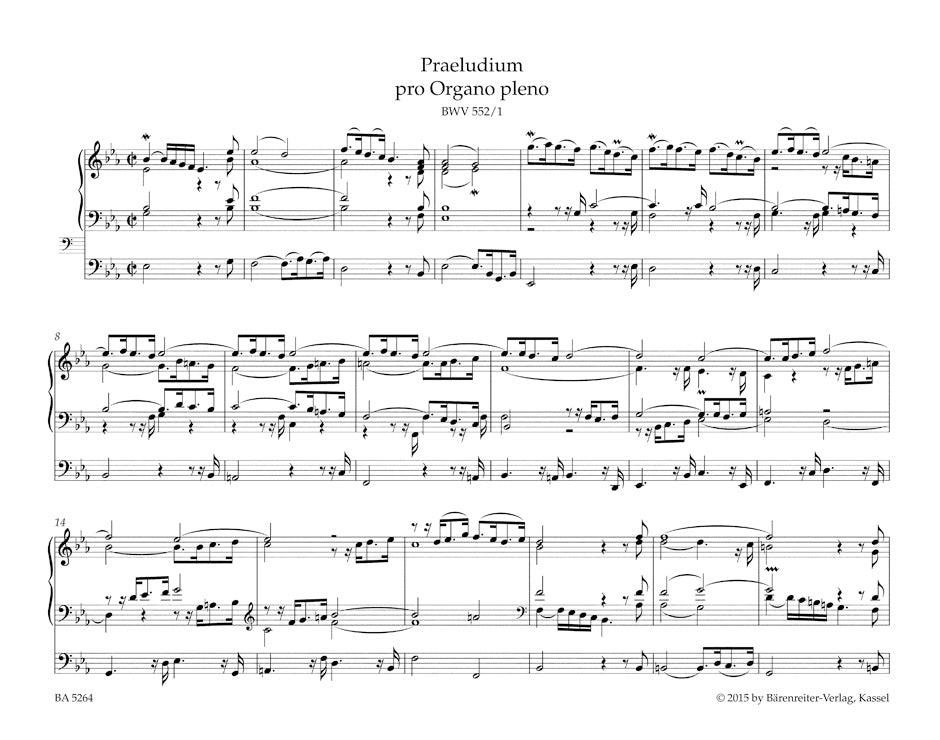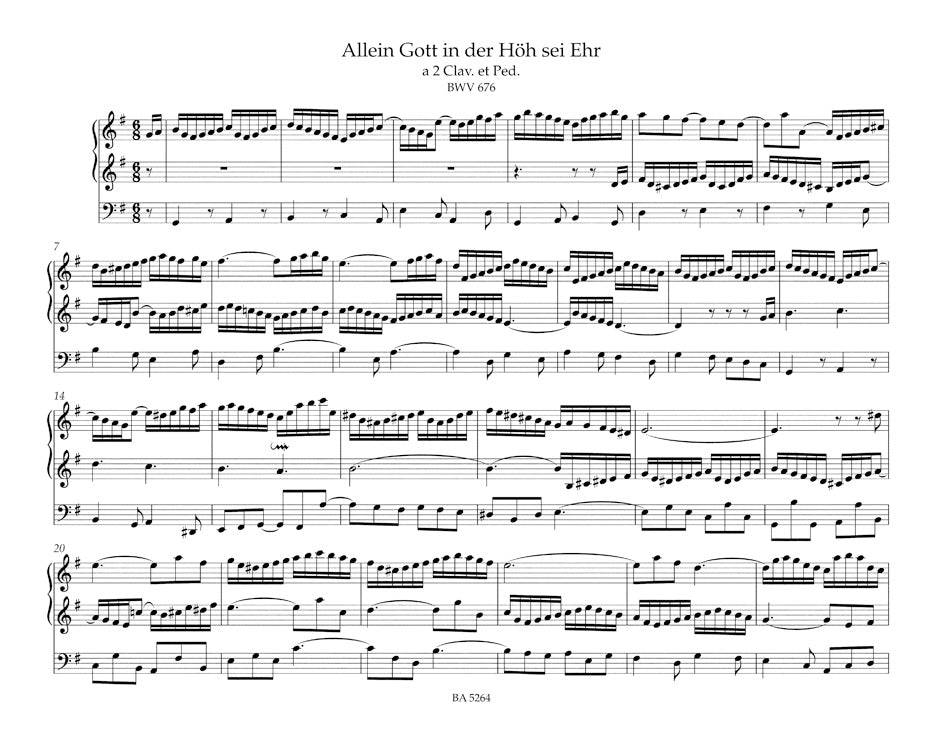Bach: Organ Works - Volume 4
Third Part of the Clavier Übung
In stock and typically ships within 1 business day.
- Composer: Johann Sebastian Bach (1685-1750)
- Editors: Manfred Tessmer, Christoph Wolff
- Instrumentation: Organ
- ISMN:
- Size: 12.0 x 9.4 inches
- Pages: 99
- Urtext / Critical Edition
Description
Replaces BA 5174
In 1739 Bach's Third Part of the Clavier Übung was published on 80 pages closely printed. Ever since then the collection has been regarded as a high point in the history of organ composition as it offers an impressive cross section of Bach's artistry.
This present volume is an updated edition of Volume 4, Series IV, of the New Bach Edition, presented by Manfred Tessmer in 1969. A fully revised edition proved unnecessary, as there were relatively few corrections affecting the musical text. However, the volume now includes a detailed Preface by Christoph Wolff which discusses not only the work's genesis but also offers an up-to-date description of the sources. for the new engraving of the musical text page-turns were reviewed and improved.
Bach's autograph is considered lost and so the main source is the original print of the collection from 1739. in collaboration with the Leipzig Bach Archive and its database Bach digital this new edition includes links to two important copies of the original print which contain hand-written entries by Bach himself.
Any complete scholarly-critical edition of the works of Johann Sebastian Bach must, in the interest of its use by researchers and performers, incorporate intervening new discoveries wherever possible. with this in mind, Bärenreiter has entered an agreement with the Leipzig Bach Archive to reissue particular volumes as applicable, either in updated performing editions based on the New Bach Edition or in thoroughly revised editions based on the New Bach Edition - revised. in this way, each new performing edition will represent the cutting edge of research.
Further hallmarks of this new generation of Urtext editions will be detailed, up-to-date Prefaces and newly engraved musical texts with optimum page turns. Each volume will list incipits with links to the relevant manuscripts in Bach digital thereby enabling the user to gain quick access to the sources.
-With altered readings integrated into the musical text taking into account new musicological evidence -With a new Preface (Ger/Eng) discussing this work and its sources by Christoph Wolff -With links to the relevant sources in Bach digital via http://links.baerenreiter.com -Newly engraved and with improved page turns -Format: 24cm x 30.5cm
Contents:
- Vorwort
- Preface
- The Melodies Used in the Third Part of the Clavier Übung
- Praeludium pro Organo pleno BWV 552/1
- Kyrie, Gott Vater in Ewigkeit BWV 669
- Christe, aller Welt Trost BWV 670
- Kyrie, Gott heiliger Geist BWV 671
- Kyrie, Gott Vater in Ewigkeit BWV 672
- Christe, aller Welt Trost BWV 673
- Kyrie, Gott heiliger Geist BWV 674
- Allein Gott in der Höh sei Ehr BWV 675
- Allein Gott in der Höh sei Ehr BWV 676
- Fughetta super "Allein Gott in der Höh sei Ehr" BWV 677
- Dies sind die heiligen zehen Gebot BWV 678
- Fughetta super "Dies sind die heiligen zehen Gebot" BWV 679
- Wir gläuben all an einen Gott BWV 680
- Fughetta super "Wir glauben all an einen Gott" BWV 681
- Vater unser im Himmelreich BWV 682
- Vater unser im Himmelreich BWV 683
- Christ, unser Herr, zum Jordan kam BWV 684
- Christ, unser Herr, zum Jordan kam BWV 685
- Aus tiefer Not schrei ich zu dir BWV 686
- Aus tiefer Not schrei ich zu dir BWV 687
- Jesus Christus, unser Heiland, der von uns den Zorn Gottes wandt BWV 688
- Fugue super "Jesus Christus, unser Heiland" BWV 689
- Duetto I BWV 802
- Duetto II BWV 803
- Duetto III BWV 804
- Duetto IV BWV 805
- Fugue a 5 con Pedale, pro Organo pleno BWV 552/2
Publishers use a lot of words to describe what they sell, and we know it can be confusing. We've tried to be as clear as possible to make sure you get exactly what you are looking for. Below are descriptions of the terms that we use to describe the various formats that music often comes in.
Choral Score
A score for vocalists that only contains the vocal lines. The instrumental parts are not there for reference. Generally, cheaper than a vocal score and requires multiple copies for purchase.
Facsimile
Reproductions of the original hand-written scores from the composer.
Full Score
For ensemble music, this indicates that the edition contains all parts on a single system (there are not separate parts for each player). In larger ensembles, this is for the conductor.
Hardcover
Hardbound. Generally either linen-covered or half-leather.
Orchestral Parts
Similar to a wind set, this is a collection of parts. In the case of strings, the numbers listed are the number of copies included, though generally these are available individually (often with minimum quantities required).
Paperback
When publishers offer multiple bindings (e.g. hardcover) or study scores, this is the "standard" version. If you're planning to play the music, this is probably what you want.
Performance / Playing Score
A score of the music containing all parts on one system, intended for players to share. There are not separate parts for each player.
Set of Parts
For ensemble music, this indicates that there are separate individual parts for each player.
Solo Part with Piano Reduction
For solo pieces with orchestra, this is a version that contains a piano reduction of the orchestra parts. For piano pieces, two copies are typically needed for performance.
Study Score
A small (think choral size) copy of the complete score meant for studying, and not playing. They make great add-ons when learning concertos and small chamber works.
Vocal Score
A score prepared for vocalists that includes the piano/organ part or a reduction of the instrumental parts.
Wind Set
For orchestral music, this is a collection of wind and percussion parts. The specific quantities of each instrument are notated.
With Audio
In addition to the printed music, the edition contains recordings of the pieces. This may be an included CD, or access to files on the internet.
With / Without Fingering (Markings)
Some publishers prepare two copies - a pure Urtext edition that includes no fingering (or bowing) suggestions and a lightly edited version that includes a minimal number of editorial markings.





